Abstract
Laboratory investigations were conducted to study the growth dynamics of Pseudomonas pickettii in commercial 0.9% sodium chloride solution under various environmental conditions and to determine the retention of these organisms after challenge through a 0.2-micron cartridge filter system. Low numbers of P. pickettii (1 to 10 CFU/ml of test solution) inoculated into commercial vials containing 5 ml of 0.9% sodium chloride solution and 500-ml volumes of 0.9% sodium chloride solution were shown to proliferate over a 168-h incubation period. These organisms demonstrated growth over a wide range of temperatures (15 to 42 degrees C) in this salt solution, and survival studies at 50, 55, and 60 degrees C indicated that this strain was not unusually resistant to heat (with the times required at a given temperature to reduce the surviving microbial population 10-fold [D-values] being 26.0, 1.9, and 0.7 min, respectively). A challenge test demonstrated that P. pickettii organisms were not completely retained by a 0.2-micron cartridge filter. The number of organisms detected increased from 1 CFU/liter of effluent at 1 to 2 min to a maximum of 176 CFU/liter at 4 to 5 min. Our results indicate that P. pickettii can penetrate a 0.2-micron filtration system and that the passage of organisms and subsequent microbial growth in the filter effluent probably are the mechanisms by which these organisms were recovered from "sterile" commercial 0.9% sodium chloride solution.
Full text
PDF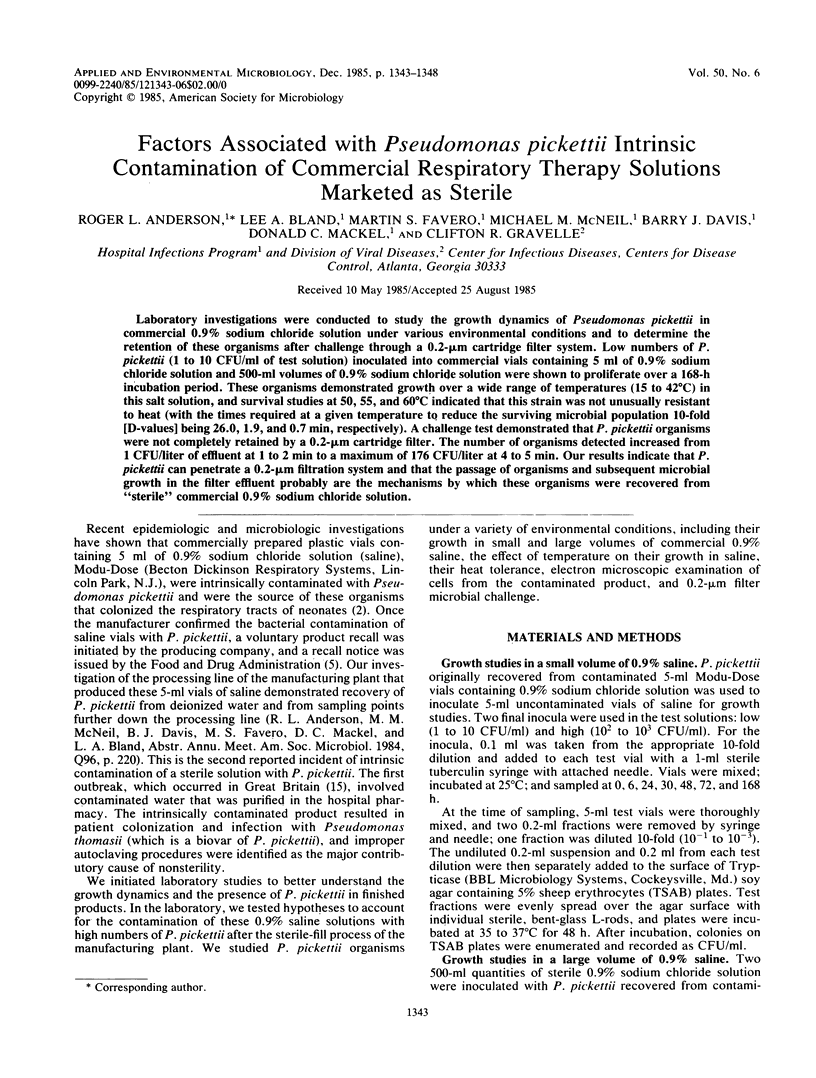
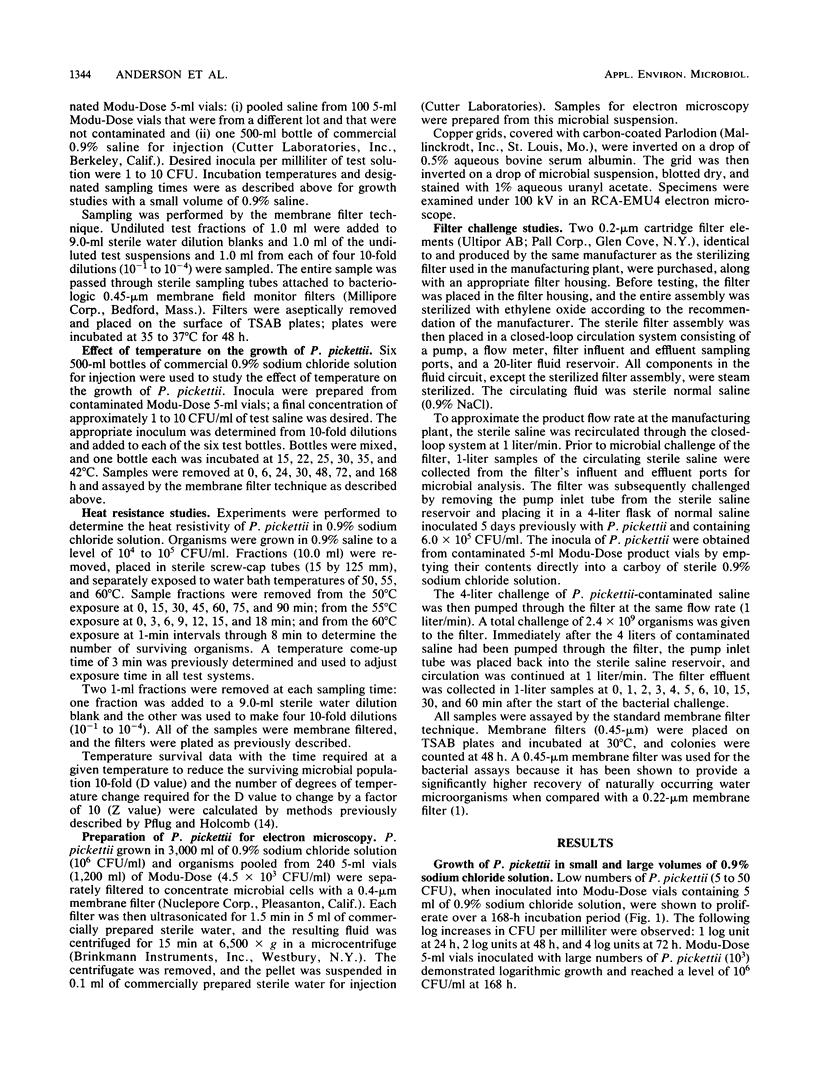
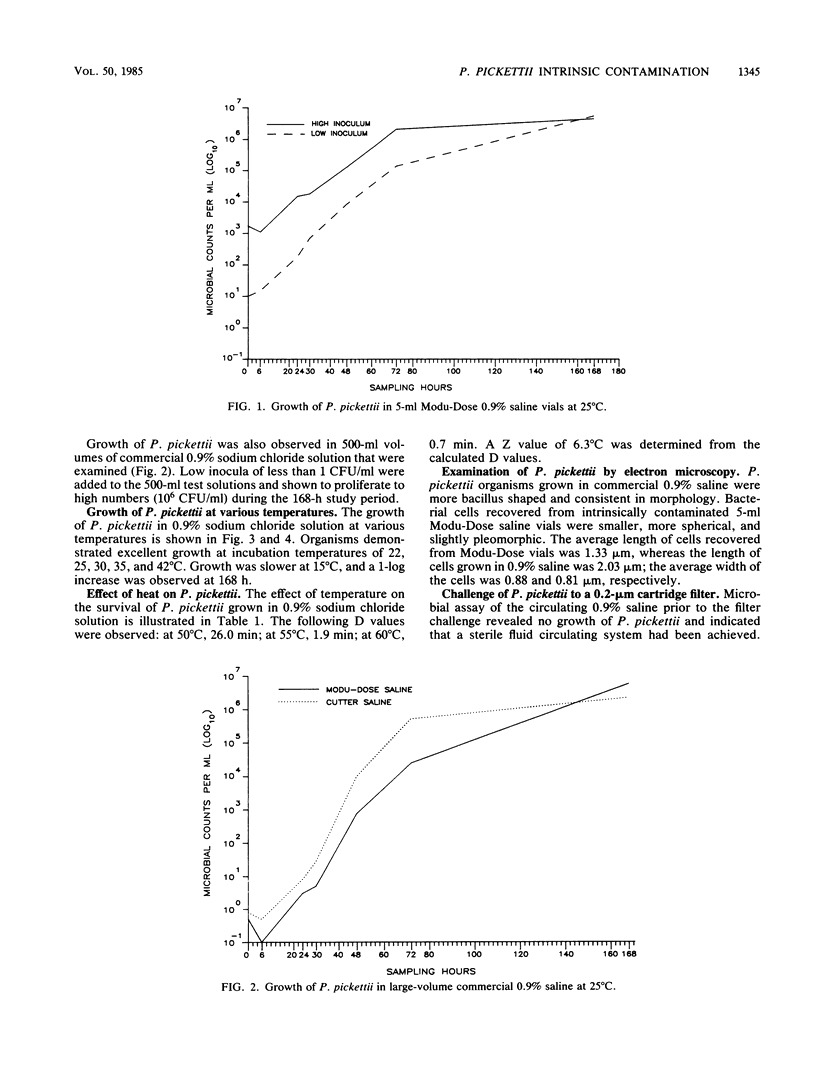
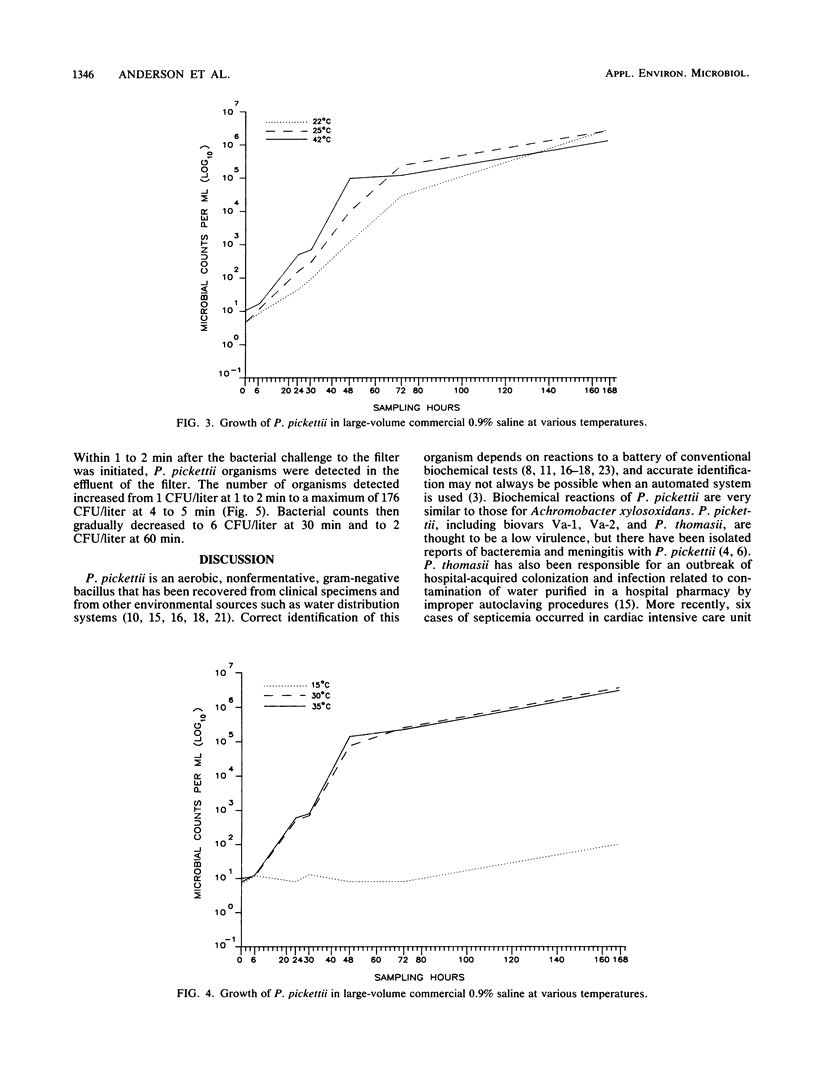
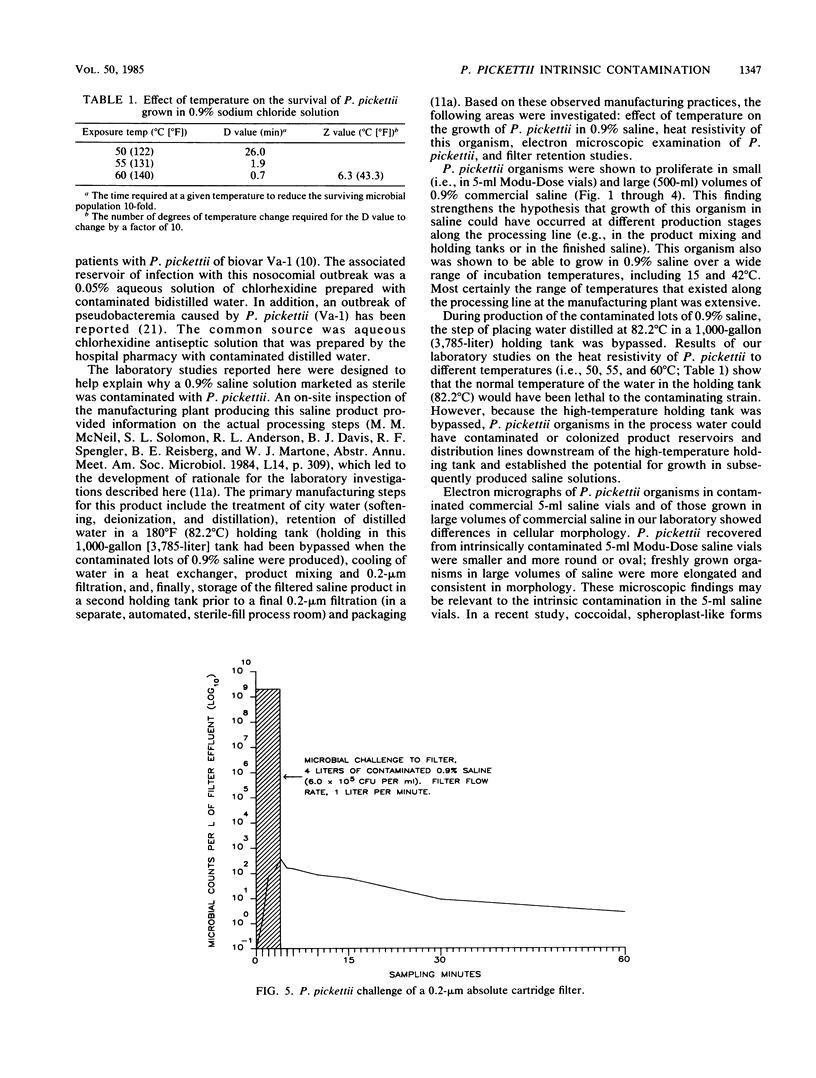
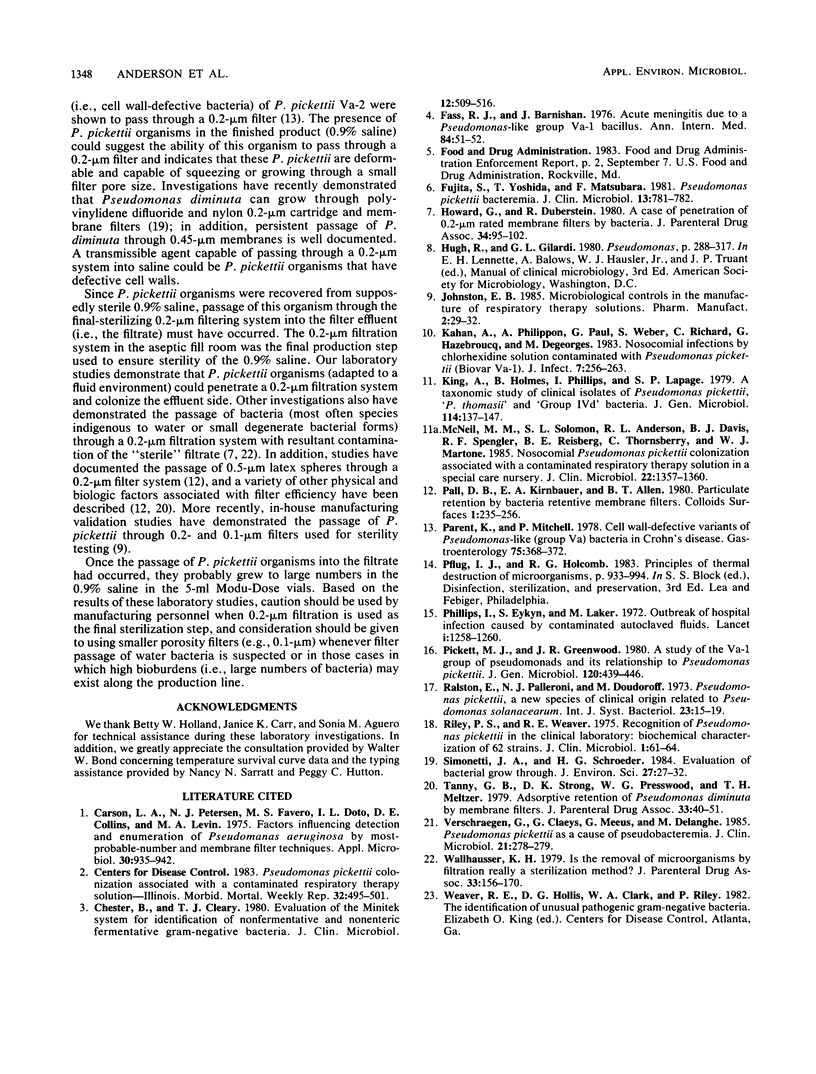
Selected References
These references are in PubMed. This may not be the complete list of references from this article.
- Chester V., Cleary T. J. Evaluation of the Minitek system for identification of nonfermentative and nonenteric fermentative Gram-negative bacteria. J Clin Microbiol. 1980 Oct;12(4):509–516. doi: 10.1128/jcm.12.4.509-516.1980. [DOI] [PMC free article] [PubMed] [Google Scholar]
- Factors influencing detection and enumeration of Pseudomonas aeruginosa by most-probable-number and membrane filtration techniques. Appl Microbiol. 1975 Dec;30(6):935–942. doi: 10.1128/am.30.6.935-942.1975. [DOI] [PMC free article] [PubMed] [Google Scholar]
- Fass R. J., Barnishan J. Letter: Acute meningitis due to a Pseudomonas-like Group Va-1 bacillus. Ann Intern Med. 1976 Jan;84(1):51–52. doi: 10.7326/0003-4819-84-1-51. [DOI] [PubMed] [Google Scholar]
- Fujita S., Yoshida T., Matsubara F. Pseudomonas pickettii bacteremia. J Clin Microbiol. 1981 Apr;13(4):781–782. doi: 10.1128/jcm.13.4.781-782.1981. [DOI] [PMC free article] [PubMed] [Google Scholar]
- Howard G., Jr, Duberstein R. A case of penetration of 0.2-micrometer rated membrane filters by bacteria. J Parenter Drug Assoc. 1980 Mar-Apr;34(2):95–102. [PubMed] [Google Scholar]
- Kahan A., Philippon A., Paul G., Weber S., Richard C., Hazebroucq G., Degeorges M. Nosocomial infections by chlorhexidine solution contaminated with Pseudomonas pickettii (Biovar VA-I). J Infect. 1983 Nov;7(3):256–263. doi: 10.1016/s0163-4453(83)97196-7. [DOI] [PubMed] [Google Scholar]
- King A., Holmes B., Phillips I., Lapage S. P. A taxonomic study of clinical isolates of Pseudomonas pickettii, 'P. thomasii' and 'group IVd' bacteria. J Gen Microbiol. 1979 Sep;114(1):137–147. doi: 10.1099/00221287-114-1-137. [DOI] [PubMed] [Google Scholar]
- Parent K., Mitchell P. Cell wall-defective variants of pseudomonas-like (group Va) bacteria in Crohn's disease. Gastroenterology. 1978 Sep;75(3):368–372. [PubMed] [Google Scholar]
- Phillips I., Eykyn S., Laker M. Outbreak of hospital infection caused by contaminated autoclaved fluids. Lancet. 1972 Jun 10;1(7763):1258–1260. doi: 10.1016/s0140-6736(72)90981-6. [DOI] [PubMed] [Google Scholar]
- Pickett M. J., Greenwood J. R. A study of the Va-1 group of pseudomonads and its relationship to Pseudomonas pickettii. J Gen Microbiol. 1980 Oct;120(2):439–446. doi: 10.1099/00221287-120-2-439. [DOI] [PubMed] [Google Scholar]
- Riley P. S., Weaver R. E. Recognition of Pseudomonas pickettii in the clinical laboratory: biochemical characterization of 62 strains. J Clin Microbiol. 1975 Jan;1(1):61–64. doi: 10.1128/jcm.1.1.61-64.1975. [DOI] [PMC free article] [PubMed] [Google Scholar]
- Tanny G. B., Strong D. K., Presswood W. G., Meltzer T. H. Adsorptive retention of Pseudomonas diminuta by membrane filters. J Parenter Drug Assoc. 1979 Jan-Feb;33(1):40–91. [PubMed] [Google Scholar]
- Verschraegen G., Claeys G., Meeus G., Delanghe M. Pseudomonas pickettii as a cause of pseudobacteremia. J Clin Microbiol. 1985 Feb;21(2):278–279. doi: 10.1128/jcm.21.2.278-279.1985. [DOI] [PMC free article] [PubMed] [Google Scholar]
- Wallhäusser K. H. Is the removal of microorganisms by filtration really a sterilization method? J Parenter Drug Assoc. 1979 May-Jun;33(3):156–170. [PubMed] [Google Scholar]


